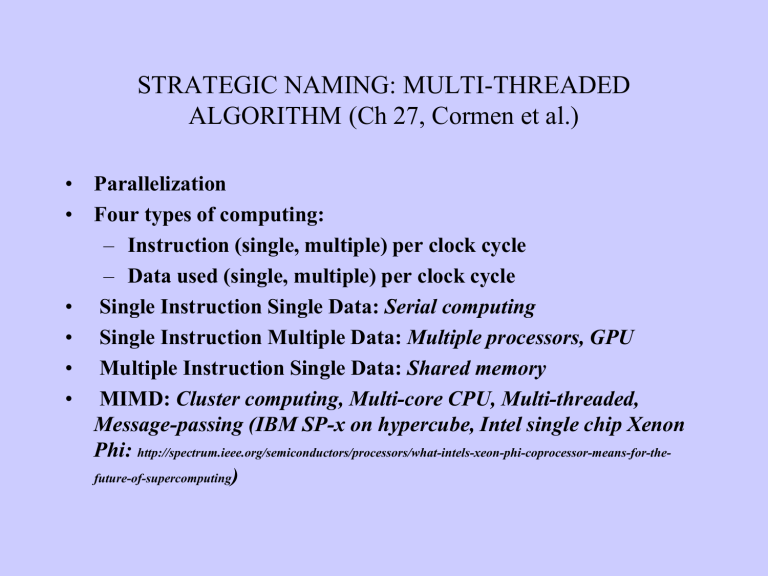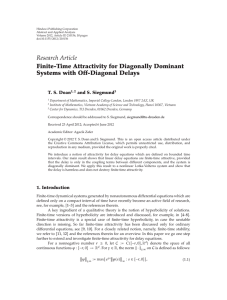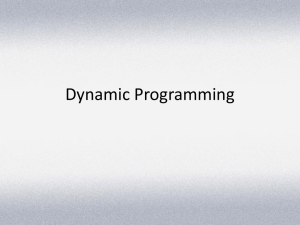Parallel Programming

STRATEGIC NAMING: MULTI-THREADED
ALGORITHM (Ch 27, Cormen et al.)
• Parallelization
• Four types of computing:
– Instruction (single, multiple) per clock cycle
–
Data used (single, multiple) per clock cycle
• Single Instruction Single Data: Serial computing
• Single Instruction Multiple Data: Multiple processors, GPU
• Multiple Instruction Single Data: Shared memory
• MIMD: Cluster computing, Multi-core CPU, Multi-threaded,
Message-passing (IBM SP-x on hypercube, Intel single chip Xenon
Phi: http://spectrum.ieee.org/semiconductors/processors/what-intels-xeon-phi-coprocessor-means-for-thefuture-of-supercomputing
)
Grid Computing & Cloud
• Not necessarily parallel
• Primary focus is the utilization of CPU-cycles across
• Just networked CPU’s, but middle-layer software makes node utilizations transparent
• A major focus: avoid data transfer – run codes where data are
• Another focus: load balancing
• Message passing parallelization is possible: MPI, PVM, etc.
• Community specific Grids: CERN, Bio-grid, Cardio-vascular grid, etc.
• Cloud: Data archiving focus, but really commercial versions of Grid,
CPU utilization is under-sold but coming up: expect service-oriented software business model to pick up
RAM Memory Utilization
•
Two types feasible:
•
Shared memory:
•
Fast, possibly on-chip, no message passing time, no dependency on a ‘pipe’ and its possible failure
•
But, consistency needs to be explicitly controlled, that may cause-deadlock, that needs deadlock checking-breaking mechanism adding overhead
•
Distributed local memory:
• communication overhead
• ‘pipe’ failure possibility is a practical problem
• good model where threads are independent of each other
• most general model for parallelization
• easy to code, & well-established library (MPI)
• scaling up is easy – on-chip to over-the-globe
Threading Types
•
Two types feasible:
•
Static threading: OS controls, typically for single-core CPU’s (why
would one do it? - OS), but multi-core CPU’s use it if compiler guarantees safe execution
•
Dynamic threading: Program controls explicitly, threads are created/destroyed as needed, parallel computing model
Multi-threaded Fibonacci Recursive
Fib (n)
1 If n<=1 then return n; else
2.
x = Fib(n-1);
3.
y = Fib(n-2);
4.
return (x+y).
Complexity: O(G n ), where G is Golden ration ~1.6
Fibonacci Recursive
Fib (n)
1 If n<=1 then return n; else
2.
x = Spawn Fib(n-1);
3.
y = Fib(n-2);
4.
Sync;
5.
return (x+y).
Parallelization of threads is optional: scheduler decides (programmer, script translator, compiler, os)
Spawn, or Data
collection node is counted as time unit 1
This is message passing
Note,
GPU/SIMD uses different model:
Each thread does same work
(kernel), & Data goes to shared memory
•
GPU-type parallelization’s ideal time ~critical path length
•
The more balanced the tree is the shorter the critical path
Terminologies/Concepts
• For P available processor: T inf
, T
P
, T
1
: no-limit to serial-processor
• Ideal parallelization: T
P
= T
1
/ P
• Real situation: T
P
>= T
1
/ P
• T inf is theoretical minimum feasible, so, T
P
>= T inf
• Speedup factor = T
1
/ P
• T
1
/ T
P
<= P
• Linear speedup: T
1
/ T
P
= O(P) [e.g. 3P +c]
• Perfect linear speedup: T
1
/ T
P
= P
• My preferred factor would be T
P factor?)
/ T
1
(inverse speedup: slowdown
– linear O(P); quadratic O(P 2 ), …, exponential O(k P , k>1)
Terminologies/Concepts
• For P available processor: T inf
, T
P
, T
1
: no limit to serial processor
• Parallelism factor: T
1
/ T inf
– serial-time by ideal-parallelized-time
– note, this is about your algorithm,
• unoptimized over the actual configuration available to you
• T
1
/ T inf
< P implies NOT linear speedup
• T
1
/ T inf
<< P implies processors are underutilized
• We want to be close to P: T
1
/ T inf
P, as in limit
• Slackness factor: (T
1
/ T inf
) / P , or (T
1
/ T inf
P)
• We want slackness
1, minimum feasible
– i.e, we want no slack











